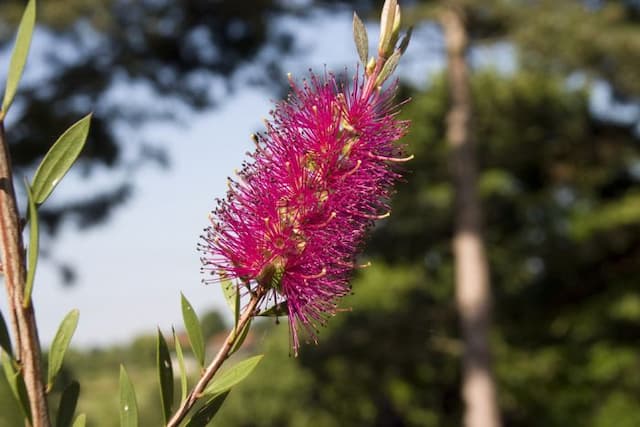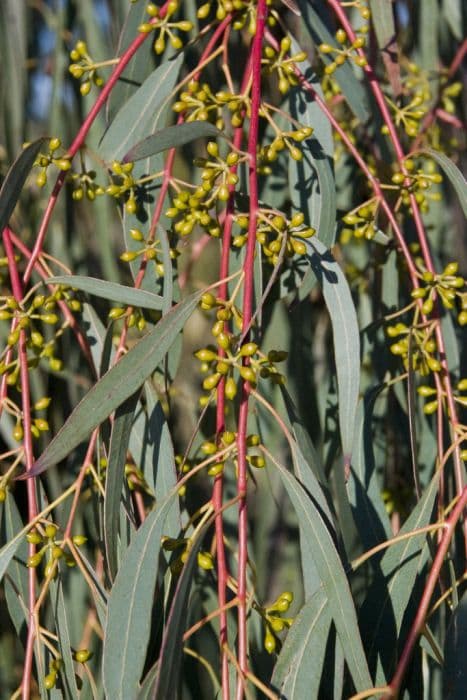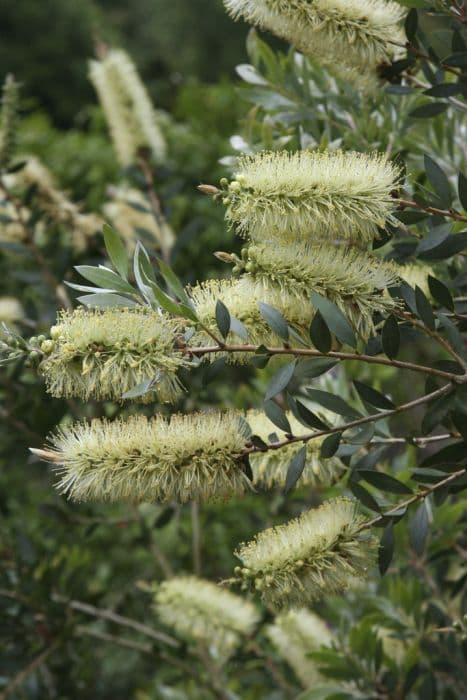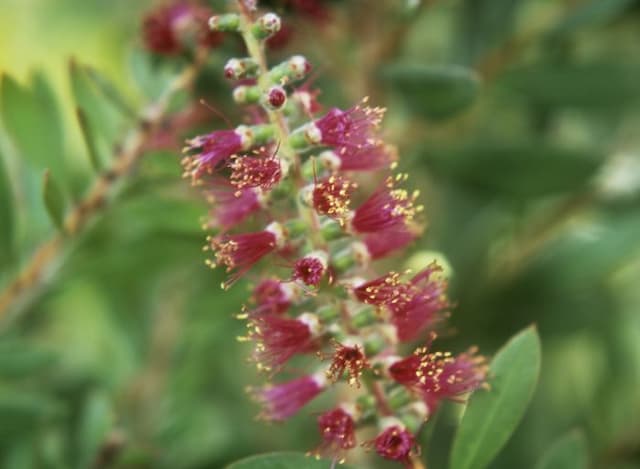Bottlebrush Callistemon 'Masotti' (PBR)

ABOUT
The Callistemon 'Masotti', commonly known as the Dwarf Bottlebrush, is a compact shrub known for its distinctive and attractive flowers. The plant boasts a dense, bushy growth habit, characterized by small, narrow, and evergreen leaves that provide a lush backdrop for the vibrant blooms. These leaves are typically a rich, dark green hue, lending a year-round verdancy to the plant’s appearance. The most striking feature of the Dwarf Bottlebrush is its flowers, which are what give the plant its common name. The blooms are arranged in cylindrical spikes that resemble a traditional bottlebrush or the bristles of a brush used for cleaning bottles. These flowers are a brilliant red color, adding a bold splash to the garden when the plant is in bloom. The flower spikes are often abuzz with pollinators, particularly attracted to the nectar-rich blossoms. Adding to its charm, after the flowering season, the Dwarf Bottlebrush produces small, woody capsules that contain seeds, clustered around the stems where the flowers once thrived. These capsules can persist on the plant for an extended period before releasing the seeds. The overall aesthetic of the Callistemon 'Masotti' is one of a well-proportioned, rounded shrub that provides a strong visual interest with its combination of colorful flowers and textured, evergreen foliage. It is popular in ornamental gardens for its manageable size and is often used in borders, as a low hedge, or an accent plant to bring year-round appeal and vibrancy to the landscape.
About this plant
 Names
NamesFamily
Myrtaceae
Synonyms
Masotti Bottlebrush, Dwarf Bottlebrush
Common names
Callistemon 'Masotti' (PBR)
 Toxicity
ToxicityTo humans
The Callistemon 'Masotti', commonly known as Bottlebrush, is not generally considered toxic to humans. Ingestion of parts of this plant is not typically associated with serious poisoning. However, as with any plant, individual allergies or sensitivities could occur, and ingesting plant material may cause mild gastrointestinal upset in some people.
To pets
Bottlebrush, the common name for Callistemon 'Masotti', is not generally recognized as being toxic to pets. It is not known to cause serious poisoning in animals. Nonetheless, pets consuming parts of this plant may experience mild gastrointestinal discomfort, such as vomiting or diarrhea, particularly if ingested in large quantities. As with any non-food plant, it is advisable to prevent pets from eating this plant to avoid any potential upset.
 Characteristics
CharacteristicsLife cycle
Perennials
Foliage type
Evergreen
Color of leaves
Green
Flower color
Red
Height
3 feet (0.91 meters)
Spread
3 feet (0.91 meters)
Plant type
Shrub
Hardiness zones
9
Native area
Australia
Benefits
 General Benefits
General Benefits- Attractive Flowers: Produces vibrant red brush-like flowers that are visually appealing.
- Wildlife Appeal: Attracts birds, particularly honeyeaters, and beneficial insects due to its nectar-rich flowers.
- Easy Maintenance: Known for being low-maintenance, requiring minimal pruning and care.
- Drought Tolerance: Once established, it is relatively drought tolerant, making it suitable for dry climates.
- Adaptable: Can grow in a range of soil types, though it prefers well-drained conditions.
- Compact Size: 'Masotti' is a dwarf variety, making it ideal for small gardens or limited spaces.
- Frost Resistance: Offers a good level of frost resistance compared to other varieties.
- Landscape Versatility: Can be used in landscape design as hedges, focal points, or in containers.
- Long Blooming Period: Has a prolonged flowering season which can extend from spring into summer.
 Medical Properties
Medical PropertiesThis plant is not used for medical purposes.
 Air-purifying Qualities
Air-purifying QualitiesThis plant is not specifically known for air purifying qualities.
 Other Uses
Other Uses- Floral Arrangements: The vibrant red brush-like flowers of the bottlebrush make it popular in fresh and dried floral arrangements, adding a touch of Australian charm to bouquets and centerpieces.
- Low Hedges: By trimming and shaping, bottlebrush can be used to create low, dense hedges for garden borders and pathways.
- Wildlife Attraction: A natural source of nectar, the flowers of bottlebrush attract hummingbirds, butterflies, and bees, making it ideal for wildlife gardens.
- Topiary: With regular pruning, bottlebrush can be sculpted into various shapes and forms, which is great for structured garden designs.
- Erosion Control: The plant's root system helps stabilize soil in sloped gardens and areas prone to erosion.
- Windbreaks: When planted in rows, bottlebrush can act as a windbreak, providing shelter from strong winds for more delicate plants.
- Sound Barrier: Due to its dense foliage, bottlebrush can be used to reduce noise pollution in suburban gardens.
- Privacy Screening: Grown as a tall shrub, bottlebrush can provide privacy screens for patios, decks, and swimming pool areas.
- Festive Decor: During the holiday seasons, its bright red flowers can be incorporated into wreaths and other festive decorations.
- Bonsai: With its adaptable nature, bottlebrush can be trained as a bonsai plant, making it a unique addition to indoor or outdoor bonsai collections.
Interesting Facts
 Feng Shui
Feng ShuiThe Bottlebrush is not used in Feng Shui practice.
 Zodiac Sign Compitability
Zodiac Sign CompitabilityThe Bottlebrush is not used in astrology practice.
 Plant Symbolism
Plant Symbolism- Resiliency: The hardy nature of the Bottlebrush plant, which Callistemon 'Masotti' is commonly known as, symbolizes the ability to withstand difficult conditions and bounce back.
- Endurance: Bottlebrush plants are known for their long blooming season and ability to endure various climates, representing the trait of enduring hardships over time.
- Cleansing: The brush-like flowers are reminiscent of a traditional cleaning brush, symbolizing purification and the sweeping away of negative energy.
- Attraction: With its vibrant red flowers, the Bottlebrush is often associated with the power to attract new things into one's life, such as love, wealth, or positive energies.
- Protection: In some cultures, the Bottlebrush plant is thought to have protective qualities, providing a shield against harm and bad influences.
 Water
WaterBottlebrush 'Masotti' prefers consistently moist soil, so it should be watered regularly, but without waterlogging. During the active growing season in spring and summer, watering might be necessary once or twice a week depending on the climate. It's important to allow the soil to dry slightly between watering. Approximately 1 gallon per watering for a medium-sized shrub should suffice. In the cooler months, reduce watering to every two weeks or less, ensuring the plant is not sitting in overly wet soil which can lead to root rot.
 Light
LightThe Bottlebrush 'Masotti' thrives in full sun, where it can receive at least six hours of direct sunlight daily. An ideal spot would be in an open garden space or near a south-facing wall that provides ample sunlight throughout the day. Although it can tolerate partial shade, the plant will produce fewer flowers and may become leggy.
 Temperature
TemperatureThe Bottlebrush 'Masotti' can withstand a range of temperatures but grows best when the thermometer reads between 50°F and 90°F. It can survive brief frosts down to about 20°F, but prolonged exposure to freezing temperatures can cause damage. For optimal growth and flowering, keep the Bottlebrush 'Masotti' in a location where it is protected from extreme cold.
 Pruning
PruningPrune the Bottlebrush 'Masotti' to maintain shape and encourage bushier growth, remove any dead or diseased wood, and promote better airflow within the plant. The best time for pruning is after the plant has finished flowering, typically in late spring or early summer. Prune sparingly; excessive cutting back can reduce flowering in the following season. Regularly remove spent flowers to encourage a second bloom.
 Cleaning
CleaningAs needed
 Soil
SoilThe Bottlebrush 'Little John', prefers well-draining soil with a slightly acidic to neutral pH between 6.0 to 7.0. A mix of loamy soil, sand, and peat moss can work well, ensuring good drainage and aeration. Regularly adding organic matter can help maintain soil health.
 Repotting
RepottingThe Bottlebrush 'Little John' should be repotted every 2-3 years or when it outgrows its current pot, ensuring to use a well-draining soil mix and a slightly larger pot to accommodate its growth.
 Humidity & Misting
Humidity & MistingThe Bottlebrush 'Little John' tolerates a wide range of humidity levels but thrives best at moderate humidity, between 40-60%. It does not require any special humidity considerations when grown in its natural outdoor environment.
 Suitable locations
Suitable locationsIndoor
Place in bright, indirect light and well-draining soil.
Outdoor
Plant in sun to partial shade and protect from cold winds.
Hardiness zone
8-11 USDA
 Life cycle
Life cycleThe common name for Callistemon 'Masotti' (PBR) is Bottlebrush 'Masotti'. The life of Bottlebrush 'Masotti' begins with seed germination, where environmental conditions trigger the dormant seed to sprout. The seedling stage follows, where the plant establishes its root system and first leaves, requiring consistent moisture and light. The vegetative growth stage is next, characterized by rapid stem and leaf development, during which the plant should be in well-draining soil and full sun to partial shade to thrive. The plant then enters the flowering stage, producing distinctive brush-like flowers that attract pollinators, generally seen in late spring to summer. As the plant matures, it enters a maintenance stage, where it needs pruning to shape and promote denser foliage and more prolific blooming in the following seasons.
 Propogation
PropogationPropogation time
Spring-Early Summer
The most popular method of propagating the Callistemon 'Masotti', commonly known as Dwarf Bottlebrush, is through semi-hardwood cuttings. This technique is typically performed in the late summer when growth from the current season has started to mature but is not fully hardened. To propagate by cuttings, take a 4 to 6 inch (10 to 15 centimeters) cutting from the current year's growth, ensuring it includes at least one set of leaves. Strip the leaves from the bottom half of the cutting and dip this end into a rooting hormone powder to facilitate root development. The cutting should then be placed in a well-draining potting mix, kept moist and out of direct sunlight until roots have established. This can take several weeks, during which a plastic cover can help maintain humidity. Once rooted, the new Dwarf Bottlebrush plants can be gradually acclimatized to outdoor conditions before being planted in their final location.









